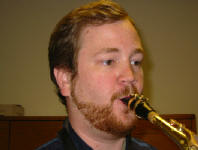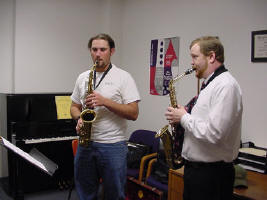|
Saxophone
Embouchure Basics |
The saxophone embouchure
must be thought of as “forward with downward pressure,” and not pulled
back in any way. One of the most common issues encountered with
the embouchures of saxophone players at any level is a tightly pulled-back
“smiling” formation with lots pressure exerted by the lower teeth and
jaw. This hinders the vibration of the reed, causing a thin, pinched
tone, poor (often sharp) intonation, and an ever-present “zing” in the
sound created by the pressure of the lower teeth biting into the reed.
There are several facets that must be examined in order to ensure that
you or your student is forming a satisfactory saxophone embouchure: embouchure
position on the mouthpiece, formation of the embouchure corners, alignment
of the upper and lower teeth, and the amount of pressure exerted by the
lower teeth/jaw.
The embouchure must make contact with the mouthpiece at the point at which
the reed and mouthpiece rails meet. This contact point can be found
by inserting a piece of paper between the reed and mouthpiece. Push
the paper downward until it comes to a comfortable stop; mark this position
with your thumb, pull the paper out, and form the embouchure at the point
marked by your thumb. You will find most often, particularly on
the bigger horns (tenor and baritone), that too little mouthpiece is going
into the mouth. Once this correct contact point has been reached,
a fuller sound should be evident.
The corners of the embouchure should
be focused inward, not pulled back as when one is smiling. With
inwardly focused corners, sufficient support is provided to the upper
and lower lips so that they will not be too tense, allowing for maximum
vibration of the reed. Tightly drawn corners, as noted above, will
hinder vibration of the reed, possibly cutting off the sound completely
(especially in the higher register), and causing a thin tone with poor
intonation. A good exercise is to whistle and notice the puckering
of the lip corners, or to think of sucking a very thick milkshake through
a straw; saying the syllable “oooh” is another excellent demonstration
for the proper inward focus of the embouchure
corners.
A further consideration is that of jaw alignment. For most of us,
the natural alignment of our jaw is that of a slight overbite, particularly
if we have had our teeth corrected by an orthodontist at some point in
our lives. A few of us, however, have naturally occurring under
bites, and it should be noted that people with severe under bites may
have trouble forming a proper embouchure. For purposes of playing
the saxophone, we should strive for an even bite; that is, the upper and
lower teeth should be in complete alignment without an overbite or under
bite. This will likely require the lower jaw to push forward just
slightly to be in alignment with the upper teeth.
A habit that many saxophonists develop very early in their playing is
biting into the lower lip with the lower teeth.
Many think that the lower lip acts
as a cushion into which your teeth can bite; again, this results in a
hindrance in the vibration of the reed, not to mention the fatigue and
pain that can be caused by the teeth actually restricting blood flow to
the lip. Therefore, the lower
teeth should merely REST against the lip, not bite into it, and the chin
muscles should be strong enough to support the lower lip (see exercises
below) to prevent the lower teeth from biting into the lip.  By
the same token, the chin should not be bunched up, but should remain in
a firm but relaxed position.
By
the same token, the chin should not be bunched up, but should remain in
a firm but relaxed position.
There
are some good exercises that can help to strengthen the embouchure muscles.
( These exercises have been adapted
and slightly varied from those in The Art of Saxophone Playing
by Larry Teal, published by Summy-Birchard.
This is an excellent resource for all students and educators.)
The first exercise begins by casually closing the jaw, allowing the bottom
teeth and top teeth to merely make contact; it is very important to not
clamp the jaw shut during this exercise.
Then, push the upper and lower lips tightly against one another, maintaining
a straight line with the lips. Again, do not clamp the jaw shut!
Hold this position for a set amount of time (five seconds when you first
begin, then increase to ten seconds, then increase to longer periods of
time), rest and repeat. The second
exercise begins with the teeth together. Slowly open the jaw while
keeping the lips closed. Open the jaw as far as you can while keeping
the lips closed, hold this position again for a set amount of time, rest
and repeat. Just like weight lifting, we are training muscles that
are probably seldom used, so take breaks often and be careful to not overdo
it. Happy exercising, but no
smiling!
| If you would like to be added to the TSMP Email Mailing List and receive periodic notifications of new articles and updates to this website, then please email TSMP.
The Texas School Music
Project is a source for ideas and information
concerning pedagogical
practices in the music classroom or rehearsal hall. The TSMP is a service provided to
all music specialists by the faculty
of
the Department of Music
at Stephen F. Austin State University. Copyright © 2002, Department of Music at Stephen F. Austin State University |
